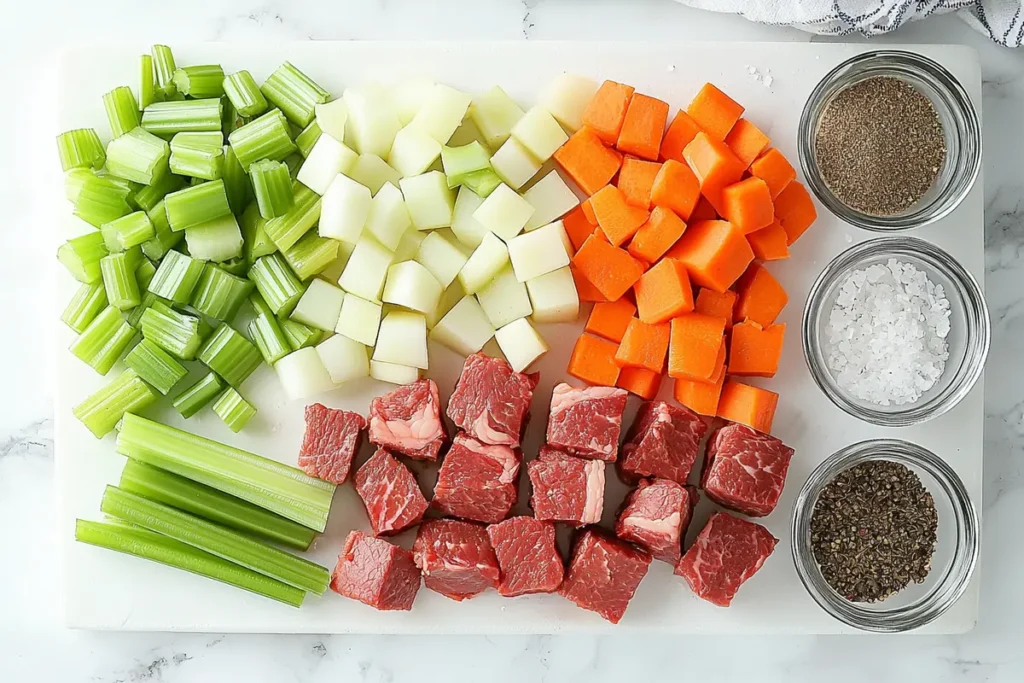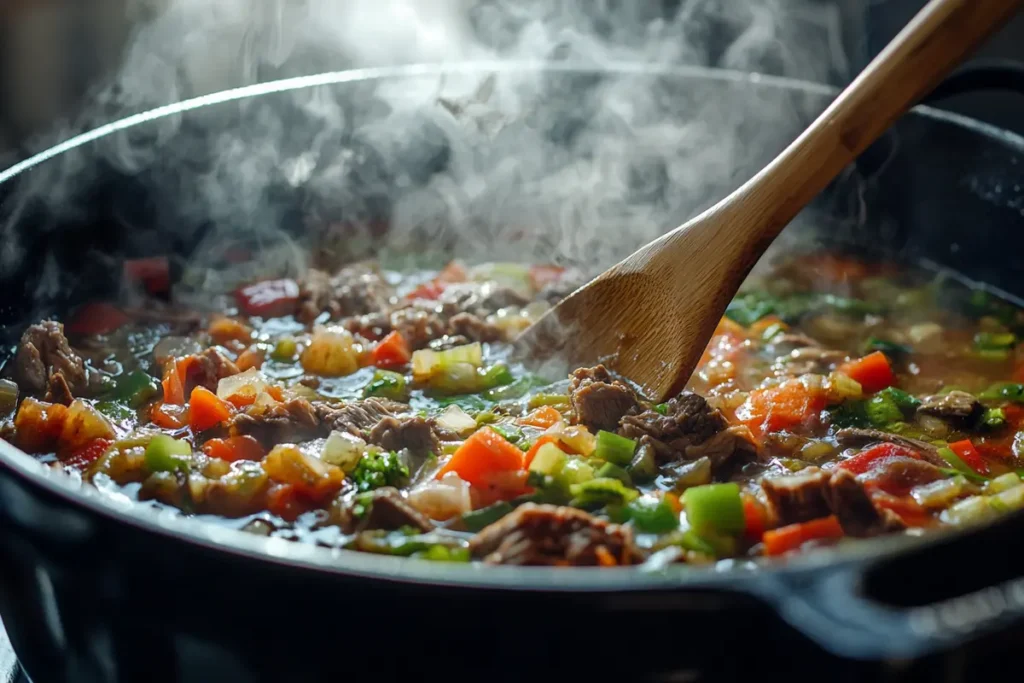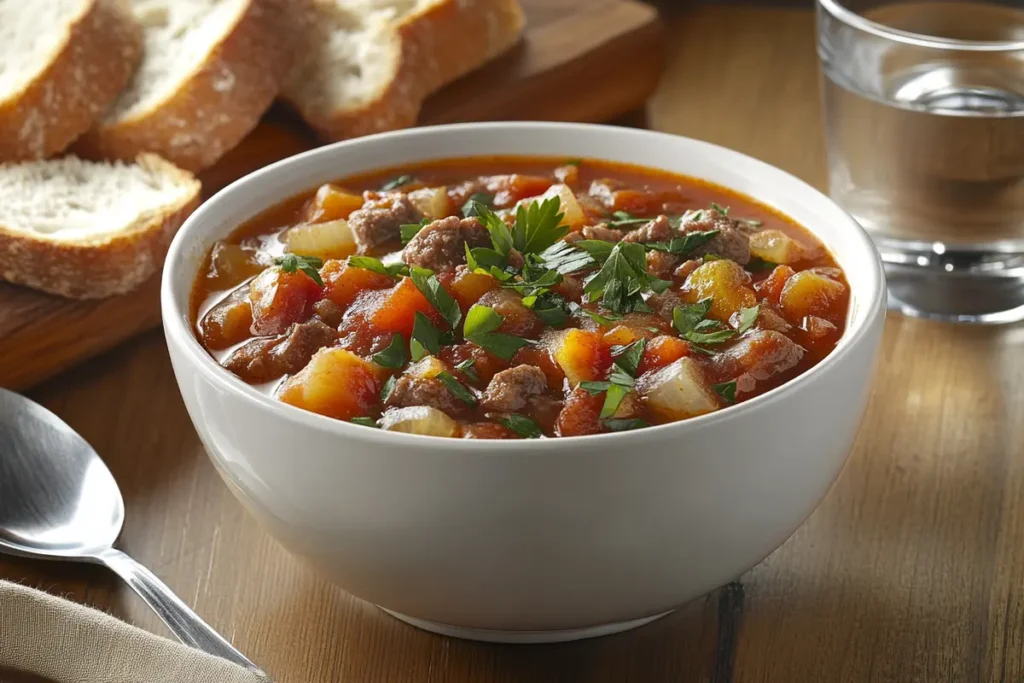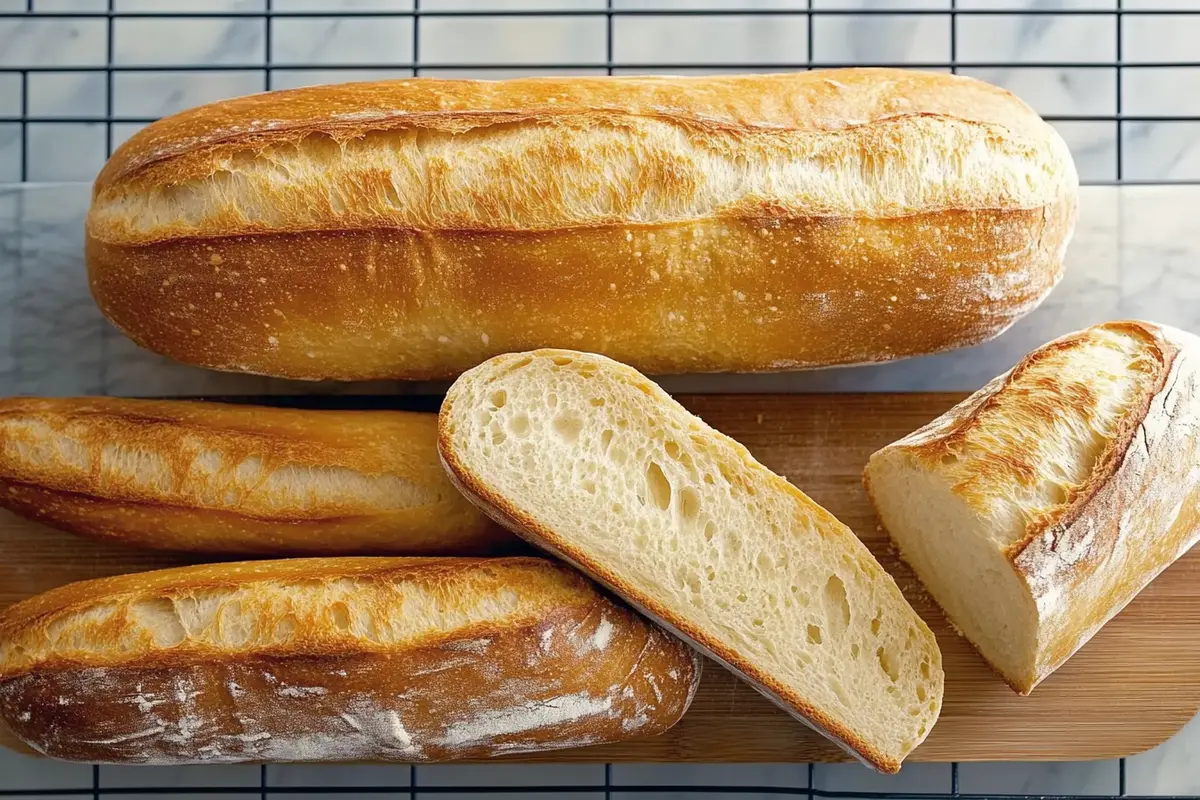Old fashioned vegetable beef soup recipe is the ultimate comfort food—warm, hearty, and full of rich, nostalgic flavors. This timeless dish blends tender beef, garden-fresh vegetables, and a savory broth to create a wholesome meal that feels like a hug in a bowl. Whether you’re cooking for your family or meal-prepping for the week, this soup is the perfect make-ahead recipe that only gets better with time.
Table of Contents
Introduction to Old-Fashioned Vegetable Beef Soup
What Makes Old-Fashioned Vegetable Beef Soup So Special
Few meals bring the same level of nostalgia and satisfaction as homemade beef and vegetable soup. With its blend of tender meat, fresh vegetables, and savory broth, it’s a true representation of comfort food. This soup has a unique ability to adapt—whether you stick to tradition or add a personal twist, it never fails to delight.
A Recipe Rooted in Tradition
Old-fashioned vegetable beef soup isn’t just a meal; it’s a story. Passed down through generations, it embodies a rich history of families gathering around the table. It harkens back to simpler times when meals were made with love and minimal ingredients—yet packed with flavor.
Why You’ll Love This Recipe
- Nutritious and Hearty: Packed with fresh vegetables and protein-rich beef, this soup is a nutritional powerhouse.
- Versatile and Customizable: You can easily adapt the recipe to include seasonal veggies or your personal favorites.
- Perfect for Any Occasion: Whether it’s a rainy afternoon or a celebratory dinner, this dish fits the bill.
Ingredients and Preparation

Essential Ingredients for Old-Fashioned Vegetable Beef Soup
Beef Selection
For the most tender and flavorful beef, opt for cuts like chuck roast or stew meat. These cuts become incredibly tender when simmered and impart a rich, savory taste to the broth. When selecting beef, look for marbling—those fine streaks of fat ensure juicy, melt-in-your-mouth meat. Avoid lean cuts, as they can turn tough after prolonged cooking.
Vegetable Medley
Classic recipes typically call for carrots, celery, potatoes, and green beans, but don’t stop there! Enhance the soup’s richness with optional additions like parsnips, peas, or even chunks of butternut squash. The key is balancing flavors—sweet carrots, earthy potatoes, and crisp green beans create a harmonious medley that stands the test of time.
Preparing Your Ingredients
Meat Preparation
Before cooking, trim excess fat from the beef to prevent a greasy broth. Cut the meat into uniform cubes, roughly 1-inch in size, to ensure even cooking. Lightly pat the beef dry with paper towels; this helps it brown better during the searing process.
Vegetable Chopping Techniques
Uniform chopping isn’t just about aesthetics; it ensures all the vegetables cook evenly. Aim for bite-sized pieces—potatoes and carrots should be no larger than ½ inch thick. Softer vegetables like peas or green beans can be left whole or halved for visual appeal. A sharp knife and a sturdy cutting board are your best allies here.
Building the Broth Base
Homemade vs. Store-Bought Broth
Homemade broth, made by simmering beef bones with aromatics like onions and garlic, delivers unmatched depth of flavor. However, if time is tight, a high-quality store-bought broth works as a convenient substitute. Look for options with low sodium to maintain control over seasoning.
Seasoning Essentials
The soul of this soup lies in its seasoning. A blend of bay leaves, thyme, parsley, and a hint of paprika infuses the broth with warmth and complexity. Salt and freshly ground black pepper are a must, while a splash of Worcestershire sauce can elevate the umami factor. Don’t forget garlic and onions—these aromatics form the backbone of your soup’s flavor profile.
Cooking Process

Searing Beef for Old-Fashioned Vegetable Beef Soup
Importance of Browning
Searing the beef isn’t just a preliminary step; it’s a game-changer. By browning the meat before adding it to the soup, you create a rich layer of flavor through the Maillard reaction—a fancy term for that irresistible caramelization process. This step builds the foundation for a robust and savory broth that canned soup simply can’t replicate.
Techniques for Effective Searing
To get that golden-brown crust, heat a large soup pot or Dutch oven over medium-high heat until it’s piping hot. Add a small amount of oil—just enough to coat the bottom. Avoid overcrowding the pan; sear the beef in batches if necessary, leaving space between the pieces. Let the beef develop a crust before flipping—don’t rush it! Once browned, remove the beef and set it aside, leaving those delicious browned bits (fond) at the bottom of the pot—they’ll dissolve into the broth for added flavor.
Layering Vegetables for Optimal Texture
Staggered Addition
Vegetables cook at different rates, so adding them all at once can result in a mushy mess. Start with hearty veggies like carrots, potatoes, and celery, as they require more time to soften. Midway through the cooking process, add green beans or parsnips, which cook faster. If you’re using peas or corn, toss them in during the last 10 minutes of simmering to preserve their vibrant color and crisp texture.
Simmering Old-Fashioned Vegetable Beef Soup to Perfection
Achieving the Right Consistency
The hallmark of an old-fashioned vegetable beef soup recipe is its balance between hearty and brothy. If the soup feels too thin, let it simmer uncovered for a few extra minutes to reduce the liquid. Conversely, if it’s too thick, add a splash of beef broth or water to loosen it up. The goal is a soup that clings slightly to the spoon without being overly dense.
Cooking Duration
Patience is key here! Allow the soup to simmer gently for 1.5 to 2 hours. This extended cooking time allows the beef to become tender and the vegetables to absorb the savory flavors of the broth. Stir occasionally to ensure nothing sticks to the bottom, but don’t overdo it, as vigorous stirring can break down the vegetables.
Serving Suggestions and Storage
Ideal Accompaniments for Vegetable Beef Soup
Bread Pairings
Nothing complements a bowl of hearty vegetable beef soup like a warm, crusty loaf of bread. A classic French baguette, with its crisp exterior and soft interior, is perfect for dipping. Rustic sourdough adds a tangy flavor that pairs beautifully with the rich broth. For those who prefer something buttery, soft dinner rolls or biscuits are delightful options. If you’re feeling adventurous, a slice of homemade cornbread can add a touch of sweetness to contrast the savory soup.
Side Dishes
Light, refreshing side dishes balance the richness of the soup. A simple green salad dressed with olive oil and lemon provides a crisp, zesty counterpoint. Pickles or a small plate of tangy coleslaw can also brighten the meal, cutting through the hearty flavors of the beef and vegetables. Keep the sides uncomplicated—after all, the soup is the star of the show!
Storing and Reheating Leftovers
Proper Storage Techniques
Old-fashioned vegetable beef soup stores exceptionally well, making it an ideal make-ahead meal. Allow the soup to cool completely before transferring it to airtight containers. Refrigerate for up to three days or freeze for up to three months. When freezing, leave some space at the top of the container to allow for expansion. For optimal quality, label containers with the storage date and avoid freezing in large portions to make reheating more convenient.
Reheating Methods
Reheating soup while retaining its original texture and flavor requires a bit of care. If frozen, thaw the soup overnight in the refrigerator before reheating. For stovetop reheating, place the soup in a pot over low to medium heat, stirring occasionally to prevent sticking or scorching. If you’re in a hurry, the microwave works too—heat in short bursts, stirring between intervals, to ensure even warming. To revive the flavors, consider adding a pinch of fresh herbs or a splash of broth.
Frequently Asked Questions
What makes vegetable soup taste better?
The secret to a flavorful vegetable beef soup lies in layering flavors. Start by sautéing onions and garlic to release their natural sweetness. Use quality beef cuts for a rich base, and don’t forget to deglaze the pot after searing the meat—those browned bits add incredible depth. Adding fresh herbs like thyme, parsley, and bay leaves during cooking will infuse the broth with aromatic notes. A splash of Worcestershire sauce or a hint of balsamic vinegar can also enhance the overall flavor.
How to add depth of flavor to vegetable soup?
Depth comes from balancing savory, sweet, and acidic elements. To achieve this, use a robust beef broth as your base. Sear the meat for a caramelized, smoky undertone. Consider adding a pinch of smoked paprika or a dash of soy sauce to amplify umami. Lastly, finish the soup with a squeeze of fresh lemon juice or a dollop of tomato paste for brightness.
How do you fix bland vegetable beef soup?
If your soup feels lackluster, start with salt—it’s the simplest fix! Then, consider adding spices like black pepper, garlic powder, or a pinch of red chili flakes. A handful of fresh herbs stirred in at the end can breathe life into the dish. Read more…
Can I use different cuts of beef for this recipe?
Absolutely! While chuck roast and stew meat are classic choices, other cuts like shank, brisket, or even short ribs can work beautifully. Just ensure the beef is well-marbled for tenderness after slow cooking.
Is it possible to make this soup in a slow cooker?
Yes, a slow cooker is an excellent option for this recipe. After searing the beef and sautéing the onions, transfer everything to the slow cooker. Cook on low for 6-8 hours or high for 3-4 hours. The long, gentle cooking process tenderizes the meat and allows flavors to meld beautifully.
What are some good substitutes for beef broth?
Vegetable broth is a great alternative, especially if you’re looking for a lighter flavor. You can also use a combination of water and beef bouillon cubes. For a richer taste, try a mix of mushroom broth and soy sauce—it mimics the savory depth of beef broth.
How can I thicken the soup if it’s too thin?
If your soup feels watery, create a slurry by mixing equal parts flour or cornstarch with cold water. Stir it into the simmering soup and let it cook for a few minutes until thickened. Alternatively, you can mash some of the potatoes or blend a small portion of the soup to add natural body.
Can I freeze the soup for later use?
Yes, old-fashioned vegetable beef soup freezes exceptionally well. Let the soup cool completely, then portion it into freezer-safe containers or bags. It will keep for up to three months. When ready to enjoy, thaw in the fridge overnight and reheat on the stovetop or microwave.
What variations can I try to change up the flavor?
Experimenting with herbs, spices, and vegetables can give this classic recipe a fresh twist. Add zucchini or bell peppers for a summery vibe, or stir in kale or spinach for a nutrient boost. You could also incorporate barley or rice to make the soup even heartier. A sprinkle of Parmesan cheese on top can add a savory finish.

Old-Fashioned Vegetable Beef Soup Recipe: A Timeless Comfort Food
- Total Time: 2 hours 5 minutes
- Yield: 6 servings
- Diet: Gluten Free
Ingredients
For the Soup Base:
- 1 ½ lbs beef chuck roast or stew meat, cut into 1-inch cubes
- 2 tablespoons vegetable oil
- 1 can (14 oz) diced tomatoes, undrained
- 1 large onion, diced
- 3 cloves garlic, minced
- 1 tablespoon Worcestershire sauce
- 4 cups beef broth (preferably low sodium)
- 1 cup water (add as needed to adjust consistency)
- 1 bay leaf
Vegetables:
- 3 medium carrots, peeled and sliced
- 3 medium potatoes, peeled and diced into ½-inch cubes
- 2 stalks celery, sliced
- 1 cup green beans, trimmed and cut into 1-inch pieces
- 1 cup frozen peas (add at the end of cooking)
Seasonings and Garnish:
- 1 teaspoon dried thyme
- 1 teaspoon dried parsley
- ½ teaspoon smoked paprika (optional, for depth)
- Salt and freshly ground black pepper to taste
- Fresh parsley, chopped (for garnish)
Instructions
1. Sear the Beef
- Heat 2 tablespoons of vegetable oil in a large soup pot or Dutch oven over medium-high heat.
- Pat the beef cubes dry with paper towels (this helps them sear better). Season with salt and pepper.
- Add the beef in batches, ensuring you don’t overcrowd the pot, and sear on all sides until browned (about 2-3 minutes per side). Remove the beef and set it aside.
2. Sauté the Aromatics
- In the same pot, reduce heat to medium and add the diced onions. Sauté for 3-4 minutes until softened.
- Add the minced garlic and cook for another minute, stirring constantly to prevent burning.
3. Build the Broth Base
- Return the seared beef to the pot and pour in the beef broth and canned diced tomatoes.
- Add Worcestershire sauce, bay leaf, thyme, parsley, and paprika (if using). Stir well to combine.
- Bring the mixture to a boil, then reduce the heat to low. Cover and let it simmer gently for 45 minutes to an hour to tenderize the beef.
4. Add the Vegetables
- After the beef has simmered, add the carrots, potatoes, and celery. Stir to combine.
- Simmer uncovered for another 20-25 minutes, or until the vegetables are tender but not mushy.
5. Add Green Beans and Peas
- Stir in the green beans and cook for 5-7 minutes.
- Add the frozen peas during the final 5 minutes of cooking to retain their vibrant color and texture.
6. Adjust the Seasoning
- Taste the soup and adjust with additional salt and pepper as needed. For more depth, add a splash of Worcestershire sauce or a pinch of paprika.
7. Serve and Garnish
- Ladle the soup into bowls and garnish with freshly chopped parsley. Serve with crusty bread or rolls for a complete meal.
- Prep Time: 20 minutes
- Cook Time: 1 hour 45 minutes
- Category: Dinner
- Method: Simmering
- Cuisine: American




